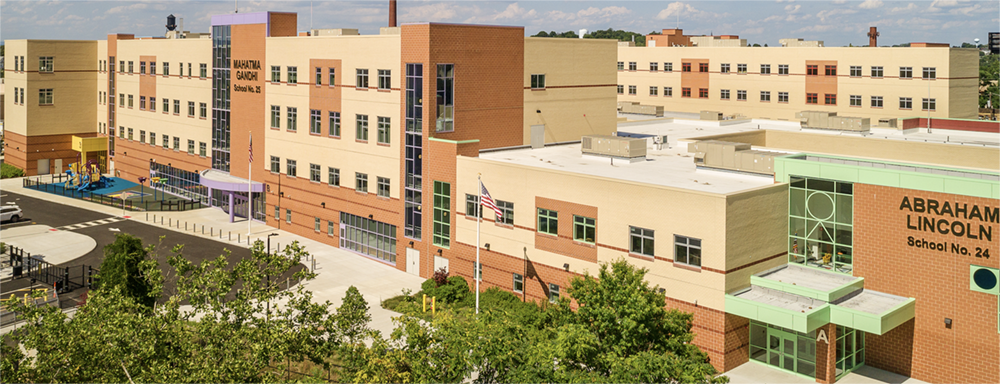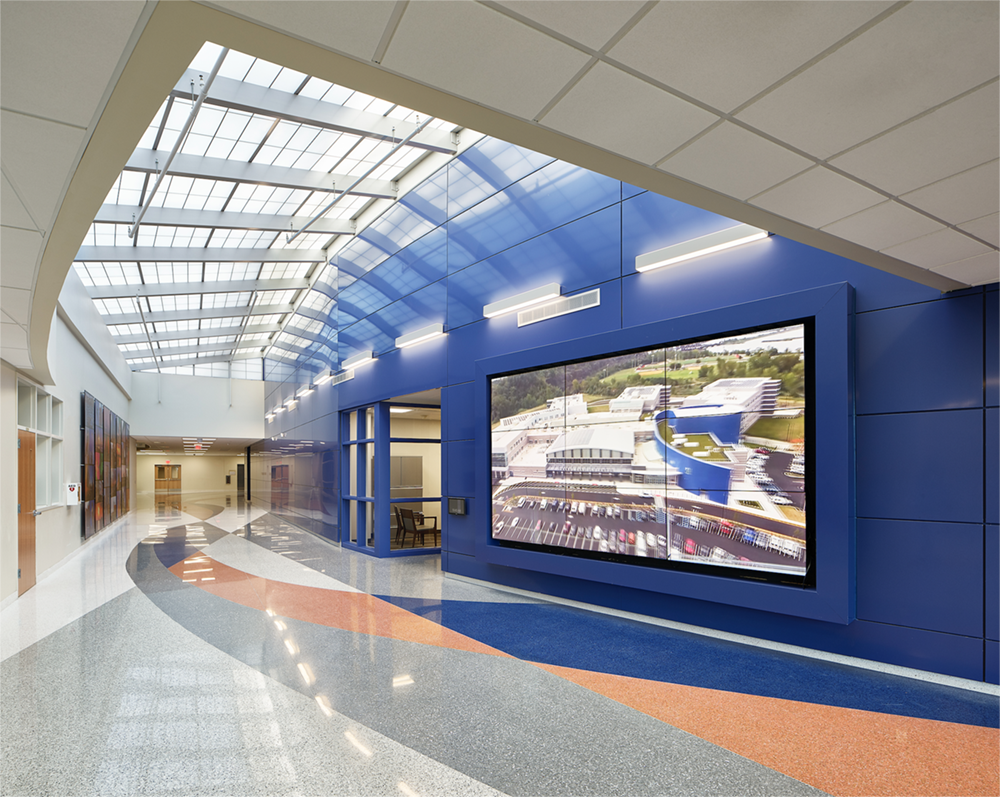“For every dollar spent on early child development you save $7 over the
life course because children with better early child development are
less likely to end up delinquent, involved in crime, unemployed and so on.”
Michael Marmot
Before 2010 costly schools ranged anywhere between $35 million to $130 million depending on your demographics and location. Today’s larger urban schools serve diverse demography’s, diverse curricula, and diversity in the scale of needs. Classwork now includes the full gamut of sciences, arts, mathematics, languages, trades, computers, CAD, and computer precision welding to Broadway level dance theater.
By the mid 1990s PSE staff was involved in educational coursework for one of the national associations in communications; teaching audio, visual, video distribution and media control systems from Orlando to Philadelphia. By 1999 our engineers were designing digital communication systems for $100 mil science high schools. And by 2015; $175 million magnet high schools with 85” hi-resolution displays in every classroom, video display labs for advanced studies, electrical, mechanical, plumbing, automotive and computer training with trade practices.
Since the 1980s PSE has been involved in educational security for public schools, colleges, and universities. In the same time period physical security and electronic security took a priority after the Virginia Tech mass shooting.
Every Child Is Perfect
Every child is perfect. In every way. A gift from creation. It is up on our shoulders – all our shoulders – to acknowledge and promote individual abilities for every child. How better to meet our goals than to provide;
- Safe schools
- Class appropriate settings
- Stimulating and engaging school environments
- Enhanced lighting, sound, networks and learning technology
Technology and Security Skills
This is a story which revolves around PSE’s design and consulting work in New Jersey, a state which adopted a leadership position in teaching urban school children to accomplish two important goals: First, improving the educational foundation for all children throughout the state; and second, reducing crime through programs.
Since the 1980s PSE had been involved in educational security for public schools, colleges, and universities. In the same time period PSE staff was honing their skills in physical security and electronic security.
The New Jersey State Legislature
Since 2000 the New Jersey State Legislature has approved $12.5 billion in funding for school facility projects including almost $9 billion for Abbott districts (tax poor districts -see reference below) and $3.5 billion for lower income districts that don’t meet the Abbott criteria. (Refer to NJ SDA resources)
In 2022 New Jersey’s Governor Murphy signed an additional $1.5 billion to pay for school facility projects in the states’ 31 public school districts while $350 million would go to non-School District Authority projects. That’s $14 billion according to the records.
Why. The education system was broken. 50-year-old schools. Dilapidated structures. Infestation and vermin. Indoor environmental concerns. Poor educational outcomes.
Just one encounter in the justice system before the age of 18 means individual and family outcomes decline rapidly; placing economic and social burdens on public health, criminal justice, homelessness, and domestic abuse. Likewise, just one encounter during one school year of a teacher of color who is of the student, will give a 70% boost to staying in school for graduation. It is a direct win-win. We will show financially how it’s true as well.
The wealth gap for those in urban and isolated rural communities can be over a factor of 10 times difference. African Americans represent 18% living below the poverty level while only 8% of non-Hispanic whites do so.
Here is how education can offset crime.
Potential earnings average more than $40,000 per year after high school graduation according to US statistics. While it’s more than $50,000 with at least 2 years of higher education. It would take an offender 20 years to equal what a graduate will make in today’s dollars based on earning $500,000 over the same period.
We need to empower Boards of education and their legislative bodies to fund education in early childhood development. Pre-K through 8.
PSE has planned and designed security and technologies for educational, trades, sciences, and arts curriculums in over $750 million of K-12 schools projects in New Jersey. It works. Here’s our example.
PSE is the Technology Engineer of Record for Perth Amboy, seven miles from NYC, in a design/ build effort constructing a $283 mil high school. The largest being built in America today. Its technology is reflective of achievement-based education at all levels – whether using intellect-based learning, physical or both.
Educational programs strive to balance the benefits of standardization to;
- Provide for greater consistency in school facility projects
- Provide quality educational facilities with greater cost effectiveness
- Reduce the time required for design and building of schools
- Serve as a foundation for higher levels of technology support
Part 2 of this narrative will describe how PSE’s electrical engineering, electronics engineering, CAD engineering and critical technology specifications play a remarkably visible role in design of our schools today – enabling better communications, education, and public safety – for the safety of our children, staff, visitors, and volunteers.
Education is not the filling of a pail, but the lighting of a fire.
William Butler Yeats
Educational, Instructional Technology, and Construction Specifications
Prior to the architects setting up CAD backgrounds and floorplans, educational specifications are developed which reflect the direct needs of curriculae in association with classroom spaces and functional needs, while elaborating on needs for school district certification by class and study.
Space planning may be accomplished during the time of educational specifications development. Once educational specifications are developed, instructional technology specifications are written. These integrate space planning for room call outs with the adoption of the educational specifications for direction and types of technology needs.
Instructional technology specifications elaborate high-speed data backbone requirements, core switching, edge switching, delivery methods of infrastructure, distribution of audio/visual/video and digital shared media, and last-mile incorporation of digital components such as digital clocks, cameras, paging systems, intercoms, digital telephones, auxiliary amplification for gymnasiums and natatorium. Wallboard enhancement systems for lectures, ADA systems for hearing and visually impaired as well as accessibility issues being addressed to heighten the level of sound or visuals for those needing additional accommodations are designed.
Finally, construction specifications detail the exact components, operational requirements and functionality, expectations of quality and interoperability, and integration with other components on the site whether physical or electronic. Construction specifications often consist of a dozen or more unique specifications including common work requirements which stipulate how the contract needs to be professionally addressed – respecting the technologies special installation needs.
Special conditions specifications reflect electrical issues conforming to code, while other technical sections form the basis of the “digital environment;” stipulating the speeds of digital data transfer, optical cable requirements, servers, core switches, patching and redundancy, optical and copper switching speeds, virtual access, and subnets.
Audio/visual specifications address sound systems and high-power LED projection with touchscreen controls and specialized loudspeakers. Security sections address monitoring alarm systems as well as panic systems and lockdown needs; ensuring safe passage with proper card access through hardened portals and openings.
One particular magnet school, with a large vocational trade component, broadcast, performing arts and computer science/coding, required a completely digital environment; no paper. A success for over six years; winning the GOLD LEED Green award for New Jersey educational facilities in 2017.
The child must know that he is a miracle, that since the beginning of the world there hasn’t been,
and until the end of the world there will not be, another child like him.
Pablo Casals









